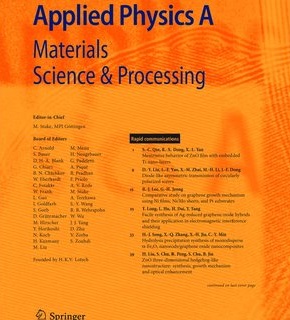Evaluation of composition-induced relaxor behavior in (1-x)BaTiO3-xBi(Zn2/3Nb1/3)O3 solid solutions
Abstract
In this reported paper, the relaxor behavior of a (1-x)BaTiO3(BT)-xBi(Zn2/3Nb1/3)O3(BZN) solid solutions prepared by implementing a mixed solid oxide route have been investigated. Structural investigation revealed that adding Bi(Zn2/3Nb1/3)O3 leads to the crossover of the tetragonal (P4mm) to the pseudo-cubic (Pm-3 m) state. A surface morphology analysis is conducted through the scanning electron micrograph and the typical grain size is observed to be reduced as the amount of Bi(Zn2/3Nb1/3)O3 rises.The dielectric performance under varying thermal conditions indicates a frequency disperse dielectric permittivity with a clear signature of relaxor behavior for x ≥ 0.01. A reduction in dielectric permittivity value from 1741 to 1245 along with the transition temperature from 303 to 253 K with composition variation is also noted from the dielectric response.The diffused phase transition is examined using a modified empirical formula. The determined values for the degree of diffuseness are observed to be increasing from 1.38 to 1.86 corresponding to the concentration, attributed to varying states of polarization and, consequently, differing times of relaxation across various regions. Vogel–Fulcher law is satisfied by the frequency-dependent temperature at the peaks of permittivity, which is regulated by the formation of PNRs at higher temperatures.The correlation between temperature and the local order parameter distinctly illustrates the transition of the structure from a state of long-range order to one of short-range order in ferroelectricity as the quantity of Bi(Zn2/3Nb1/3)O3 is increased.The ferroelectric characteristics are examined by the polarization–electric filed hysteresis loop and the Pr value decreases from 2.61 μC/cm2 to 0.23 μC/cm2 as the BZN concentration rises from 0.05 to 0.20.

 求助内容:
求助内容: 应助结果提醒方式:
应助结果提醒方式:


